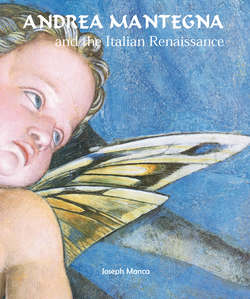Читать книгу Andrea Mantegna and the Italian Renaissance - Joseph Manca - Страница 4
Mantegna as Court Painter in Mantua
Оглавление32. The Oculus, ceiling, Camera Picta, 1474. Fresco. Ducal Palace, Mantua.
The city-state of Mantua constituted the seventh largest nation in Italy, its lands gained from years of conquest and consolidation. Although many of the Italian city-states had relatively democratic governments when they were first established in the medieval period, only a few places, most notably Florence and Venice, retained anything close to a broadly participatory form of government by the fifteenth century.
Mantua, like the neighbouring duchies of Milan and Ferrara, was ruled by one family, the government held by physical might, moral suasion, and the hope for stability and rulership passed down by hereditary title.
The Bonacolsi family maintained power in Mantua until 1328, when the Gonzaga took over. The overthrow of the Bonacolsi regime by the Gonzaga family was represented later in a dramatic battle painting from 1494.
33. Antonio Pisanello, Portrait Medal of Ludovico Gonzaga, c. 1447. Bronze, diam. 10.2 cm. Victoria and Albert Museum, London.
The Gonzaga consolidated their power during the fourteenth and early fifteenth centuries, so that by Mantegna’s time they were unquestionably in control, with landholdings and fortified castles spread across the territory (Fig. 5).
They held the title of signore, “lord”, until they were proclaimed by the Holy Roman Emperor in 1433 to hold the higher designation of marchese, or marquis in English. The political arrangement in Mantua meant there was a heliocentric regime, consisting of a court and its dependents.
In Padua, Mantegna worked for members of a merchant oligarchy, and he had to answer to the dictates of the painters’ guild; in Mantua, he served the needs of a single, powerful regime.
34. The Oculus (detail), ceiling, Camera Picta, 1474. Fresco. Ducal Palace, Mantua.
35. View of Castle of St. George showing area where Camera Picta and Studiolo were located.
Mantegna entered the post because of the desirable security and prestige it offered. When he went to Mantua in 1459 he was promised transportation for his family (one of his sons, Francesco, would later become a painter and his assistant), a generous salary, and an allowance for food and firewood. He was also honoured by being granted a coat-of-arms of his own. Mantegna’s tasks as court painter were not always lofty ones; he painted major works but also occupied himself with designing drinking cups and carpets. Even the great Leonardo da Vinci, when he became court painter in Milan in the 1480s, was asked to engage in such trivial duties along with his grander projects. The advantage of such a position was great, however, as the regular salary meant court artists did not have to wait for commissions, and they were still free to serve other patrons in different cities, as long as the ruler agreed to let them go, which he often did as a favour to the person requesting the artist’s services. Since Mantegna was a master of the first rank, he was treated and paid far better than the average craftsman. Documents indicate he had a friendly rapport with his noble patrons, although he always maintained a deferential attitude to the Mantua rulers. As a court painter in Mantua, Mantegna had secured an enviable and honourable post of employment.
36. West Wall, called The Meeting, Castle (left detail), Camera Picta, 1465–1474. Fresco. Ducal Palace, Mantua.
37. West Wall, called The Meeting, Camera Picta, 1465–1474. Fresco. Ducal Palace, Mantua.
When Mantegna first arrived in Mantua, he was lodged at a residence provided for him but he eventually built his own house in the city, which still exists (Figs. 55 and 56). Over the years Mantegna acquired several pieces of property in the area which provided income, including farm lands in the outlying areas, and commercial and residential structures in the city. He was able to provide his daughters with substantial dowries, and his estate at the time of his death included property, money, and enough funds to establish a chapel for his family. Mantua was a city of moderate size, about the same as Padua but not nearly as large as nearby Venice. The city was nearly completely surrounded by a lake, making the place a haven for mosquitoes and frogs, although the watery setting embellished Mantua, making it among the most beautiful towns in Italy. Mantegna captured the attractive quality of the city early on in his Dormition of the Virgin (Fig. 57), which includes a view of the bridge of Saint George and several Mantuan buildings in the background. In Mantua, the imposing residences of the rulers stand near the city centre and the cathedral. Mantegna would spend much of his time labouring in the Castle of Saint George, which still exists with its impressive crenelations and thick walls (Fig. 35). That castle is connected to other palaces, altogether comprising a huge complex of rooms that is largely empty now but at the time bustled with activity and held splendid furnishings and other decorative arts. One of Mantegna’s tasks as court painter was to add to this visual splendour, the amount and quality of the pictorial decorations reflecting the magnificence and prestige of the rulers. Mantegna’s first employer in Mantua was Ludovico Gonzaga (b. 1412), who ruled from 1444 until his death in 1478. He occupied himself with many of the typical activities popular at that time among the ruling classes, including hunting, hawking, horse racing, and warfare. Ludovico, like his father and grandfather before him, helped to earn money for his state by serving as a condottiere, a hired general who served other cities needing professional military leadership. A bronze medal he commissioned in 1447 from Pisanello declares him to be a military leader as well as a marchese (Fig. 33).
Конец ознакомительного фрагмента. Купить книгу
